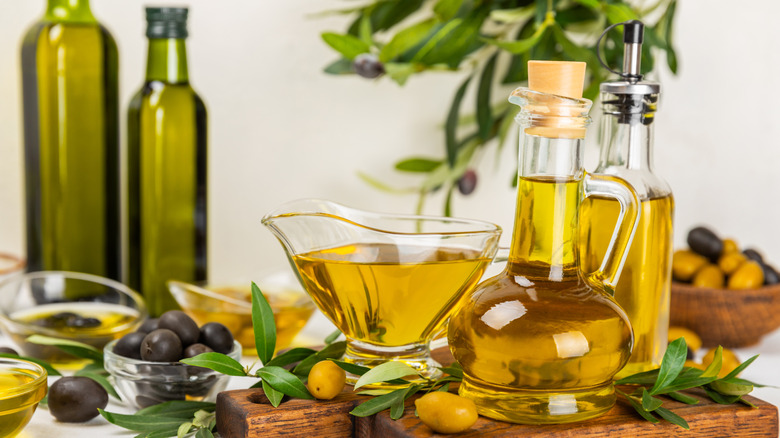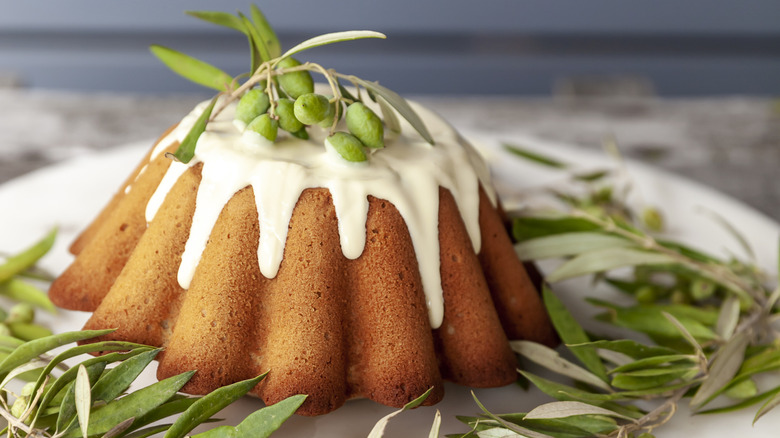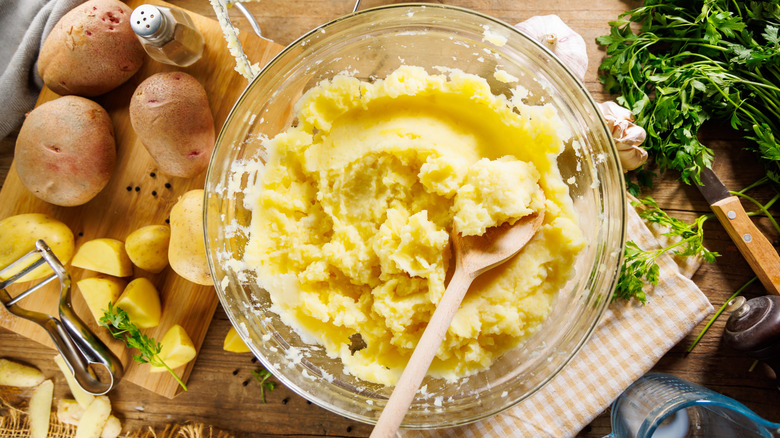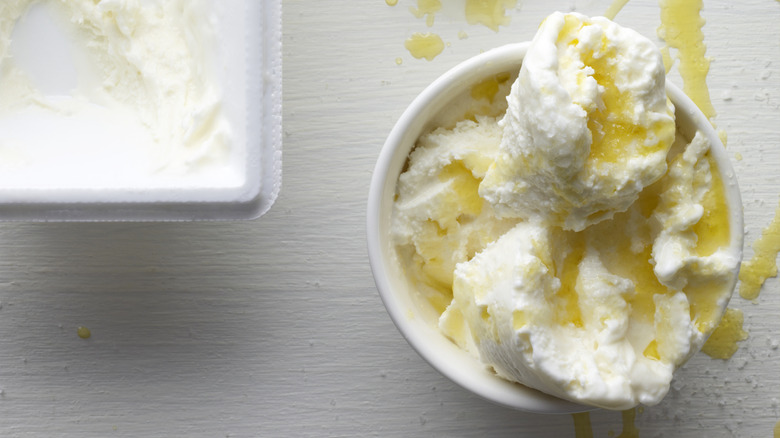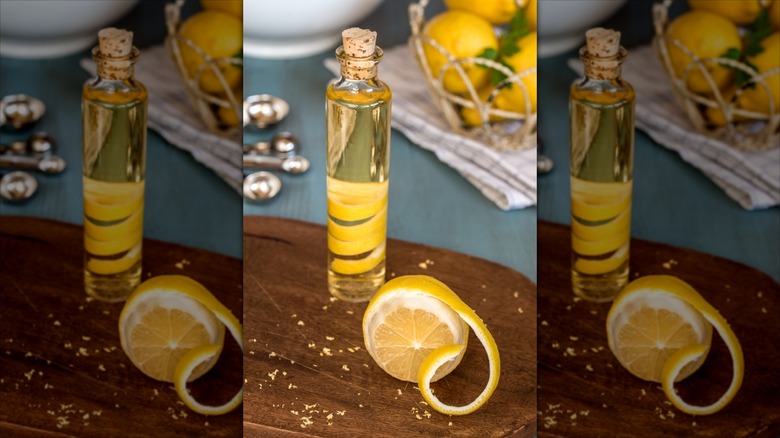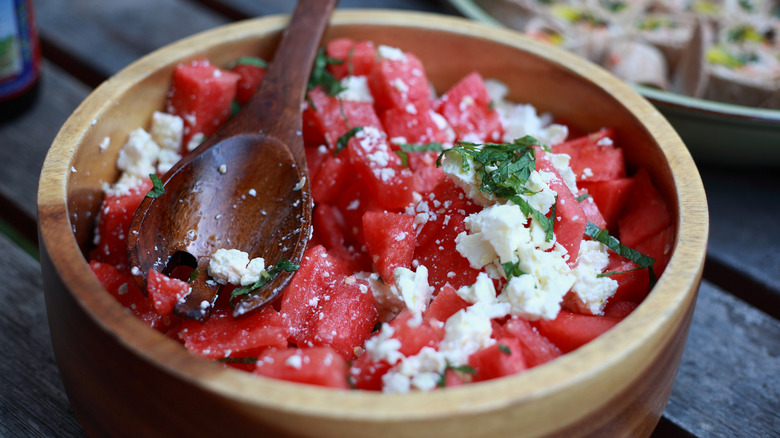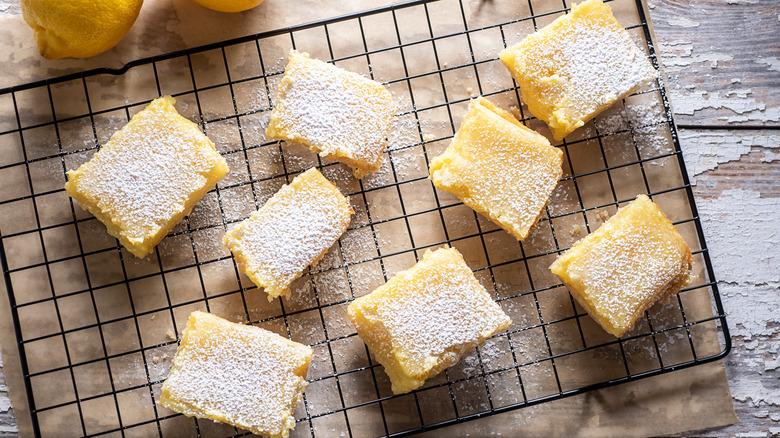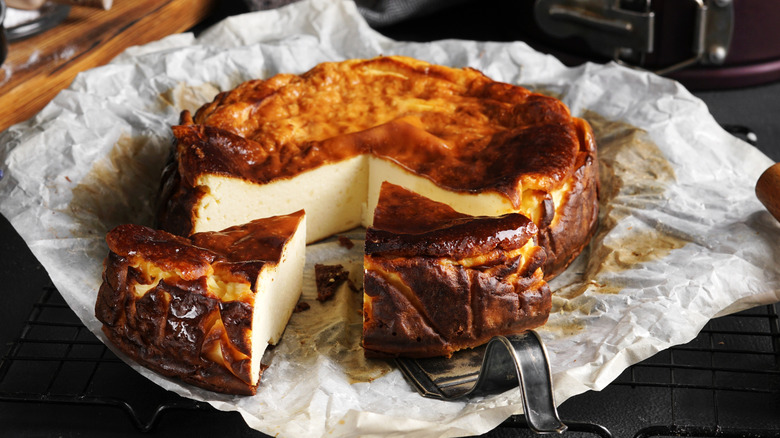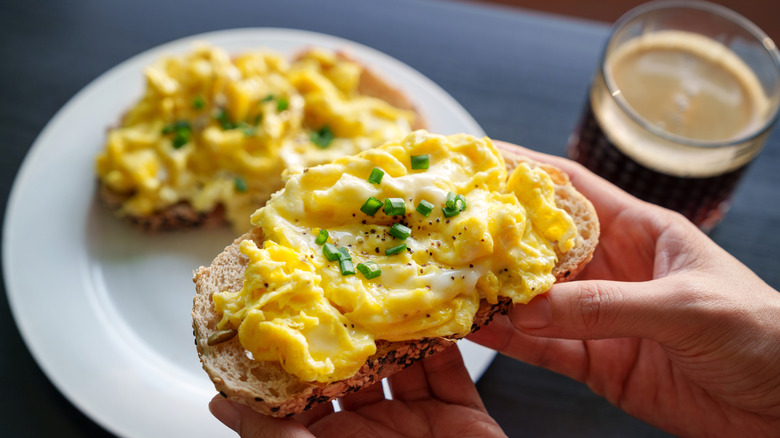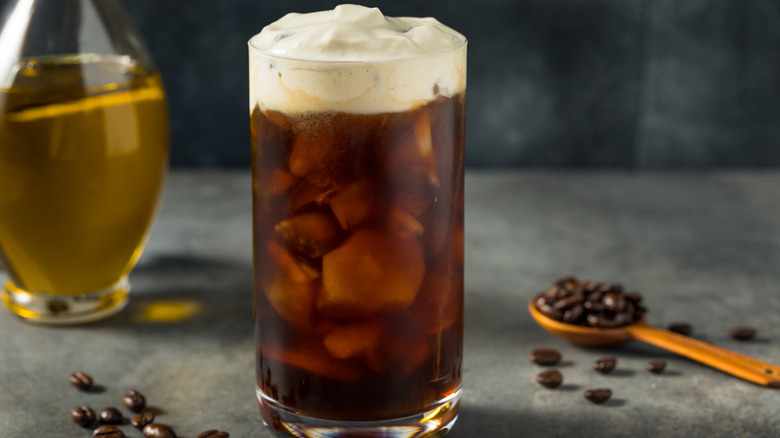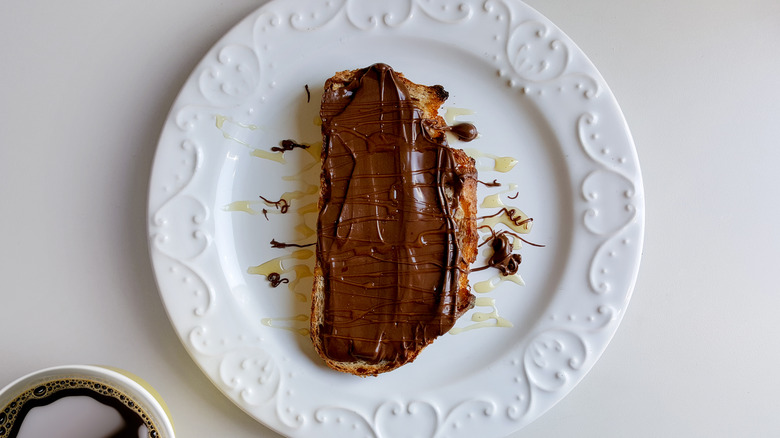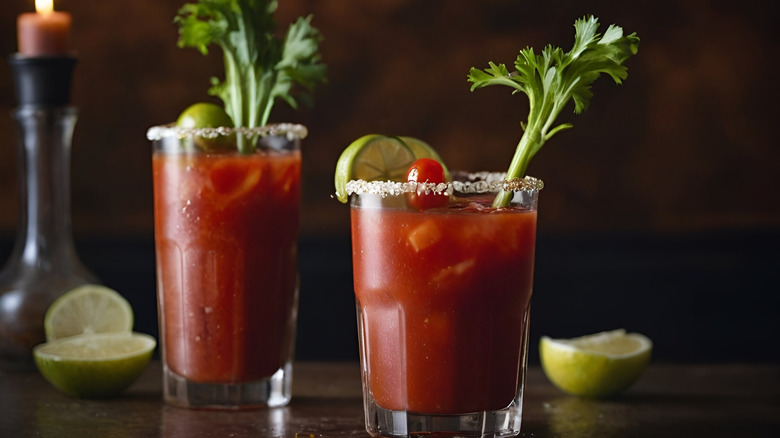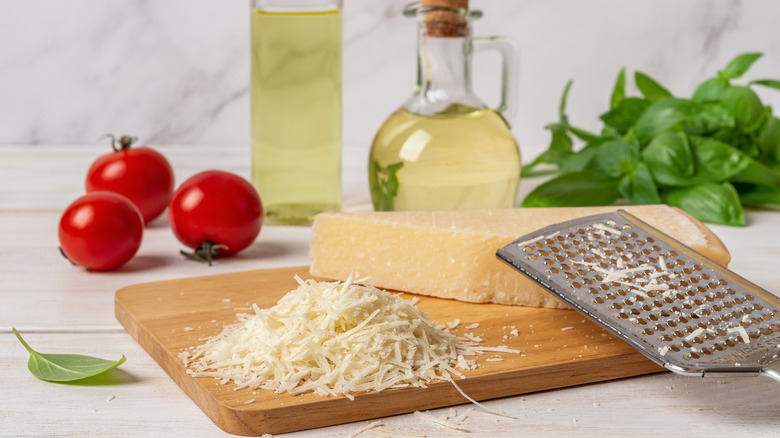14 Uncommon Ways To Use Olive Oil You'll Wish You Knew Before
Olive oil might be the world's greatest fat. As someone with an Italian heritage, I'm legally obliged to say that, but there are some good arguments for it, too. For starters, it's delicious — especially high quality extra-virgin olive oil. But it's also good for heart health, and it's more versatile than you may initially think. It's not just for roasting veggies or drizzling over pasta dishes; there are plenty of lesser-known ways to use olive oil.
We know that olive oil is expensive these days, so you probably don't want to use it for everything. But extra-virgin olive oil is at its best with 12 to 18 months of pressing, so holding onto a fancy bottle for years isn't the way to go. You should enjoy that olive oil while it's still fresh. And that's why you should try using it for everything from baking to it adding to hot drinks.
Here are 14 uncommon ways to use olive oil you'll wish you knew before. There's no chance of that special bottle of olive oil languishing in your pantry — you'll be too excited by what you can do with it.
1. Use olive oil in cake
You might not naturally reach for olive oil when you're baking a cake. Most recipes usually call for butter, and those that contain oil more often than not use a neutral flavored oil, like canola or grapeseed. But you absolutely should use this ingredient in cakes.
So, what happens when you bake a cake with olive oil? Well, you get some of those delicious fruity olive oil notes. Especially if you use a decent extra-virgin variety. Cake made with olive oil is also moister than cake made with butter, with a lighter crumb. Part of this is because oil is liquid at room temperature, while butter is solid.
There are plenty of olive oil cake recipes available online. They're often citrus flavored to complement the fruity notes of the oil. However, it also brings a richness and complexity to chocolate cake. If you want to adapt an existing cake recipe, that's possible, too. If it contains another oil, just use the same quantity of olive oil and you're good to go. If the recipe calls for butter, you should use around ¾ of a cup of oil for every cup of butter. Or around 80% oil to butter by weight. This is because butter is around 80% fat while oil is 100% fat.
2. Mash olive oil into potatoes
When you think of mashed potatoes, you probably imagine tossing in a healthy dose of butter. This gives the dish a creamy richness that you'd be lacking if you simply mashed the potatoes without any additions. But, have you ever considered making olive oil mashed potatoes?
Extra-virgin olive oil has a more complex flavor than butter. It can range from peppery to grassy to fruity, depending on the olives used to make it and how they were processed. But whatever the precise flavor profile of your olive oil, it can add a lot to potatoes. It gives them the richness and smooth texture you'd get from adding butter but with more nuance to it.
Potatoes mashed with olive oil are great as a side to Italian or other Mediterranean dishes. You might also want to add chopped fresh parsley and sautéed or roasted garlic to give them more of an Italian twist. Add around ¾ of the amount of oil as you'd usually add of butter.
3. Drizzle olive oil over ice cream
Olive oil is a lot of things, but you probably don't imagine it as an ice cream topping. Maybe it's time to expand your horizons. It's a grown-up alternative to smothering your ice cream in syrup and it's way more delicious than it sounds.
Yes, olive oil is the surprising topping you should be adding to ice cream. It's rich and creamy, like the ice cream you're drizzling it on, but adds contrast with its fruity, peppery notes and slight earthiness. It pairs well with simple vanilla but it's versatile enough to work with plenty of flavors — chocolate, pistachio, or a fruit sorbet.
There are two important things to note when pairing ice cream and olive oil. First, you need to choose a high-end ice cream with a simple flavor. Yes, Phish Food might be delicious, but it's not the sort of thing you want to drizzle olive oil over. You should aim to choose an Italian-style gelato. The other factor is the oil. Generic refined olive oil isn't going to cut it. You need to use extra-virgin olive oil and it should be at least of mid-range quality. It doesn't have to be an $80 bottle, but don't use the cheapest one from Aldi, either.
4. Pop popcorn in olive oil, or use it as a drizzle
While you might think of sweet, buttery flavors when you imagine eating popcorn, that's not the only option. The complex flavors of extra-virgin olive oil also pair well with popcorn. It's especially good if you're looking to make savory popcorn with salt or other seasonings.
One option is to pop popcorn using olive oil. This is ideal if you're using the stovetop method since you need to involve oil anyway. You heat the corn in around 2 tablespoons of oil per ½-cup of kernels, pop the lid on the pan, leaving a slight gap, and wait for the magic to happen. This gives the popcorn a light coating of oil and a mild olive oil flavor. You can then add your seasonings of choice. Savory seasonings, like smoked paprika and nutritional yeast, are great, but sweet seasonings like sugar and cinnamon can also work.
However, if you're making popcorn using a method that doesn't call for oil or you want a more pronounced olive oil flavor, you can add it as a drizzle. This is similar to the way people add melted butter to popcorn. Drizzle it over the popped corn around a tablespoon at a time and toss to coat. Keep going until you've got the flavor and coverage you want.
5. Infuse olive oil with fruit peels
You've probably used olive oil infused with garlic, herbs, or chile peppers. But these aren't the only ingredients for the job. Before you throw away your fruit peels, you might want to consider using them to infuse olive oil.
Those peels that you'd otherwise chuck straight in the trash can have a second lease of life making flavored oils. While you can experiment beyond this, we're talking about citrus peels here. Lemon and orange perhaps pair best with extra-virgin olive oil, adding some tang and brightness when drizzled over salads or pasta dishes. Other citrus like lime or grapefruit could also work but are more of a left-field choice.
All you do to make citrus-infused olive oil is take your fruit peels — taking time to wash them first and let them fully dry — and add them to a bottle or jar of olive oil. After around a week, they will have infused enough to start using. However, the citrus flavor will only get more pronounced over time. If it reaches a point where you don't want it to get any more flavorful, fish the peels out.
6. Douse watermelon in olive oil
Fruit and olive oil isn't an obvious combination, but in some cases, it works beautifully. It can level up the fruit in a way that feels totally gourmet. Dousing watermelon in olive oil gives you an elevated snack. It can also be the base for a salad.
Watermelon is sweet but complex, and the fruity yet peppery notes of olive oil complement it. You get a contrast between the freshness of the melon and the richness of the oil. You can pair just these two ingredients as a starter or snack, but you can take it even further, too. A salty cheese like feta or pecorino Romano goes nicely. Add some chopped or torn fresh mint, a squeeze of lemon, and you have yourself a nicely balanced salad. It's sweet and salty with umami notes from the cheese, acidity from the lemon, and a slight bitterness from the oil.
You could also experiment with pairing olive oil and other fruits in salads. Roasted grapes, blood orange, grapefruit, or figs are all excellent contenders. The oil helps carry flavor, making it a part of a particularly tasty salad.
7. Use olive oil in lemon bars
With a crumbly shortbread base and a rich lemon curd topping, lemon bars are an iconic sweet treat. Usually, they're made with butter, which brings a richness to them. But olive oil might be the best butter substitute for lemon bars. Forget the subtlety of a neutral oil or a dairy-free margarine, a good quality extra-virgin olive oil brings a lot to the table.
It brings peppery notes to contrast the sweetness and tartness of the lemon. Used in place of butter in the crust, its rich fruitiness stands out but it isn't immediately obvious what's bringing these flavors. If someone didn't know your lemon bars contained olive oil, they might not be able to put their finger on the flavor. But once they're aware, it seem obvious — in a delicious way.
As with other baked goods, you need to replace the butter with oil at a ratio of 4-to-3 — that's three parts oil to replace every four parts butter. As explained above, this is due to the difference in fat content between butter and oil.
8. Add olive oil to cheesecake
Cheesecake can be an over-the-top affair, piled high with rich toppings or with intensely flavored ingredients like chocolate, peanut butter, or lemon whizzed through the filling. But, it doesn't have to be that bold. Adding a high quality extra-virgin olive oil to a fairly plain cheesecake can elevate it while keeping it simple.
Do this to a vanilla cheesecake or a Basque cheesecake and you have a fancy dessert that might not be as showy as something covered in strawberry sauce or doused in caramel, but it feels way more special. It's proof that you don't need to have an elaborate dessert for it to feel like it came from a high-end bakery. In fact, simpler ones often look and taste more gourmet.
Choose a good extra-virgin olive oil with fruity and peppery notes. The pepperiness contrasts the other flavors of the cheesecake while the fruitiness complements them. You need around 3 to 6 tablespoons of oil for an average-sized cheesecake. You can replace the butter or oil in the recipe with olive oil or just add some into the mix, adjusting the other liquids to make up for it. This works best with baked cheesecakes because oil in a no-cook cheesecake will make the filling too runny. However, in a no-bake cheesecake, you could use olive oil in place of butter in the biscuit base to add to the flavor without compromising the texture.
9. Splash olive oil over scrambled eggs
If you're sick of basic breakfasts, this simple trick takes scrambled eggs to the next level. Just drizzle over some extra-virgin olive oil and you've instantly got yourself a luxury breakfast. It might seem overly straightforward, but it truly makes a difference to the flavor.
To even further elevate your scrambled eggs, serve them on a quality sourdough toast, and sprinkle some salt flakes along with the drizzle of olive oil. This adds a nice crunch to contrast the soft eggs. And make sure to use good olive oil. If you like the taste of it off a spoon, it's good enough to pull this off.
You can also add extra flavor by cooking your eggs in olive oil. If anyone ever told you not to cook with extra-virgin olive oil, don't listen to them. Sure, you probably want to save the pricey stuff for drizzling, but it's totally fine — and delicious — to cook with moderately priced EVOO.
10. Mix olive oil in coffee
Olive oil and coffee aren't obvious bedfellows but it's a combination that some people enjoy, as Starbucks' Oleato line proves. The coffee chain released various drinks, including lattes and cold brew, with an oily twist. However, they have since been discontinued in the U.S., so you might not want to get your hopes up about how good this combination is.
The idea may come from the trend of butter coffee, which is exactly what it sounds like. Using olive oil in coffee is similar but comes with the added heart-healthy benefits that this oil brings. The olive oil gives an almost velvety texture to the coffee and fruity yet savory notes. It can make subpar beans taste more interesting. But after a while, the oil can separate and leave an unpleasant texture. So, this may or may not be something you want to try yourself at home.
If you do actually want to make your own at home, there are several ways to do so. But for those who like lattes and flat whites, it's a good idea to froth or steam the milk with the olive oil to combine them and avoid getting an oily layer on top.
11. Eat olive oil on bread with chocolate
Olive oil and bread is a fairly common combination. Dipping a crusty sourdough or airy ciabatta in olive oil and balsamic is the stuff of dreams. But, you probably wouldn't expect to put olive oil on bread with chocolate. It sounds like a weird pairing but stick with us here. It's effectively a grownup chocolate spread and we're here for it.
All you need to do is grate some dark chocolate, toast bread on both sides, sprinkle the grated chocolate on the toast, and drizzle over some olive oil. You need to put the grated chocolate on the bread while it's still hot from the broiler or toaster so that it melts properly. A sprinkling of sea salt flakes provides a nice contrast and levels it up. You might also want to add some cinnamon sugar — cinnamon and chocolate are a great, under-utilized pairing.
What makes this recipe great is using good bread (something from a bakery or a homemade loaf is ideal), quality extra-virgin olive oil, and high-end chocolate. Make it on sliced white with refined olive oil and a Hershey's bar, and the results will be bordering on grim.
12. Make an olive oil bloody mary
If you love a bloody mary, it can only be improved with olive oil. This savory cocktail is a brunch classic, usually consisting of vodka, tomato juice, Worcestershire sauce, Tabasco, and a celery stick to finish things off. But you can use olive oil to create an elevated version.
Rather than using a bloody mary mix or a carton of tomato juice, you'll be making your own mix from scratch. To do so, roast tomatoes, onions, garlic, and some jalapeños, if you like your bloody marys spicy, in a generous quantity of olive oil. Once roasted, you blend the veggies with tomato juice, Worcestershire sauce, and any extras you might want, such as grated horseradish, pickle juice, lemon juice, and celery seeds.
You can make this mix on the day or up to a couple of days in advance, keeping it in the fridge until you need it. Just mix it with vodka and you've got yourself a bloody mary that's so much better than anything you'd make with a pre-mixed base.
13. Use olive oil to keep cheese from sticking to the grater
Yes, olive oil is delicious and has so many tasty applications, from the everyday to the more unusual. But it also has practical uses. If you're sick of cheese sticking to the grater, olive oil can come to the rescue.
The reason why cheese can get all clumpy and sticky when shredding it. The friction of the block on the grater creates heat, which softens the cheese, and leads to these kinds of issues. But there's an easy hack to keep cheese from sticking to the grater — coat it in olive oil. Just spray a fine mist over both sides of the grater and you'll minimize friction and prevent it from softening and sticking. If you don't have a spray bottle of oil, you can also brush a thin layer on with a pastry brush.
Olive oil prices are at a high point right now, so you definitely don't want to use your best stuff for this. But a little refined olive oil works a treat for this without being a problem for your bank balance.
14. Pour olive oil in hot chocolate
We've heard about using olive oil in coffee, but what about in hot chocolate? This warming winter favorite isn't the obvious choice for embellishing with oil but it can add to the flavor and texture. It's a great way to try something different and maybe it'll become a new favorite. Adding it to hot chocolate might be an uncommon way to use olive oil, but it's not a bad one.
Depending on the recipe, you might add anywhere between a teaspoon or a tablespoon per cup. A good extra-virgin version is ideal here. It brings the classic combination of fruitiness and pepperiness that you expect while adding a velvety texture if you manage to emulsify the oil and milk. Adding some corn flour can help keep the oil from separating and gives the drink a thicker, more luxurious texture. You can also steam or froth the milk and the oil together, which can also prevent or minimize separation.
